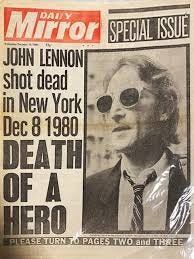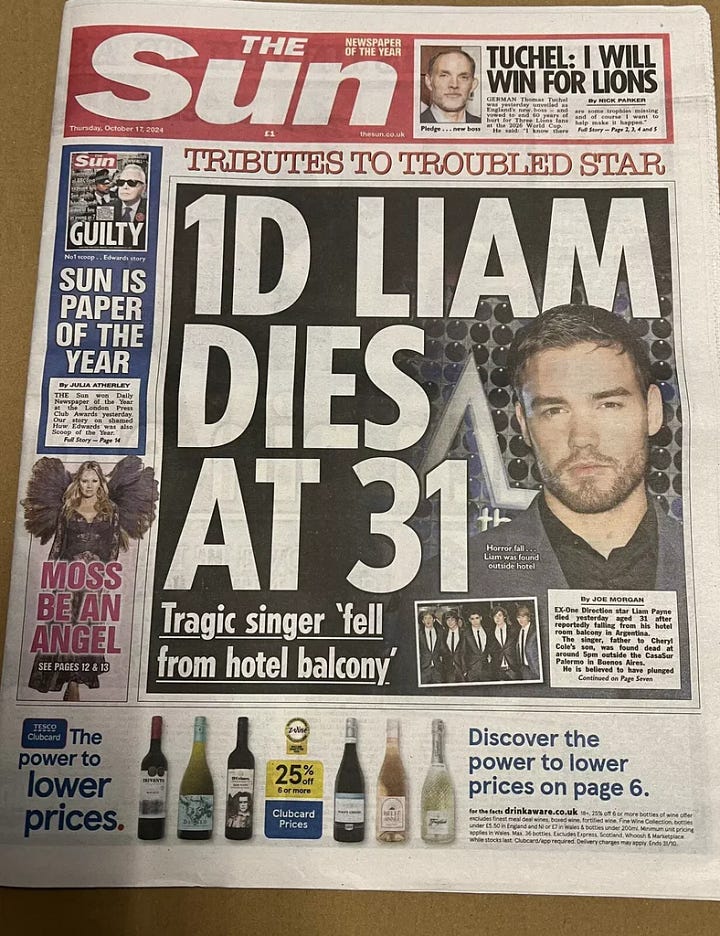Liam Payne & John Lennon Similar Scenarios
A quick note on the news of One Direction’s, Liam Payne’s death and how it reminded me of when John Lennon was assassinated
The news of One Direction’s Liam Payne’s sudden death came as a huge shock, especially to their younger fans, including my daughter, whose sadness reflected the collective grief of her generation. Watching her process this loss, reminded me of my own teenage years when I woke up to be told by my father that John Lennon had been killed. I was 18 at the time and although wasn’t the generation that saw the sensation that Lennon and The Beatles were, emerge, they had been the backdrop to my life. I recall in that moment, the shock. Like so many ‘fans’ of pop stars, even though I had never met him, his death felt personal, much like how Liam’s death now impacts my daughter and her friends.
There is a strange intimacy that we develop with public figures, especially those whose music, films, or art have shaped parts of our lives. They create something that speaks directly to our emotions, our memories, our experiences. We grow up with their work as the soundtrack to our formative years, and in many ways, they become woven into the fabric of our personal histories. For my daughter, One Direction was not just a boy band; they were the constant backdrop to her teenage years, with Liam Payne being one of the defining voices in that journey. I know, because I had to put up with hearing all about their ‘latest’ and every year, seeking out the ‘One Direction Annual’ as a Christmas stocking filler. She like so many followed his career, his highs and lows, and in a way, his music was a companion to her and her friends as they navigated their own challenges of growing up. I imagine losing him, feels like losing a piece of their own past, like a chapter that’s abruptly been closed without consent.
I remember something similar when John Lennon was killed so violently. I wasn’t a devoted fan, but The Beatles were part of the air I breathed. Their music had filled the house of my childhood, or whenever there were family parties and such. But it wasn’t just his music; Lennon’s life and his voice in the world meant something more, because he stood for certain ideals, for peace, for rebellion against convention. Even for those of us who didn’t follow his every word or song, his presence seemed reassuring, it was like knowing that somewhere in the world, Lennon was still doing his thing and that a lad from Liverpool could make the world a bit more interesting.


When public figures die, especially in shocking circumstances, we feel an almost communal loss. This is a testament to the role they play in our shared consciousness. They are larger-than-life figures, embodiments of something we have admired, been inspired by, or found comfort in. There is a sense of proximity to them that comes from years of following their careers, listening to their music, reading their words, or watching them perform. When they die, particularly suddenly, it disrupts the sense of continuity we expect from life.
Music, in particular, has a profound ability to accompany us through the various stages of life. It is there in the background during the highs and lows, during the excitement of a first concert, in the quiet moments of self-reflection, or through the difficult times when music offers a refuge. Losing the creator of that music feels personal because their work is so deeply embedded in our emotional experience.
This connection is not only about the music or the art that public figures create. It’s about what they symbolise. Whether it’s Lennon’s stance on peace and activism or Liam’s journey of personal struggle and growth, these figures often become icons of something larger than themselves. We project onto them our hopes, our aspirations, and sometimes even our fears. In a world that can feel chaotic and unpredictable, such people represent consistency, when they’re gone, it feels like a piece of that order disappears with them.
Their deaths remind us, too, of our own mortality, particularly when we too are young. Public figures are often seen as timeless, larger-than-life presences. When they die, it disrupts that illusion. It forces us to confront the fragility of life, and for a moment, the world seems just a little less stable, a little less bright. We feel a sudden awareness that life is fleeting, and that the people and things we hold dear are not guaranteed to last. Ultimately, the grief that follows the death of public figures is not just about them, it is about us. It is about the memories, emotions, and experiences that their lives and work have touched. The emotional impact speaks to the power of human connection, even when that connection is formed through the distant medium of music or public life. These figures, in their own way, have made us feel seen, understood, and less alone.
As I watch my daughter’s reaction, I see not just her sadness over Liam’s death, but a reflection of my own when I was her age, waking up to the news of John Lennon’s assassination. Across generations, we share this strange, poignant phenomenon of mourning people we have never met, but who have meant something to us nonetheless. It is a reminder that art, in all its forms, is one of the most profound ways we connect with one another, across time, across space, and even across loss.
Thank you
Personal Website: www.johnobrien.world - Anthropy Website: www.Anthropy.uk





